|
Monday, September 6, 2010
Progress Notes
Mike Wieneman (photo 01) recently sent me a number of old photographs of the Ha Ha Tonka Castle located near Camdenton.

01 Mike Wieneman One in particular was taken of the castle the day it burned back in October 21, 1942 (photo 02).
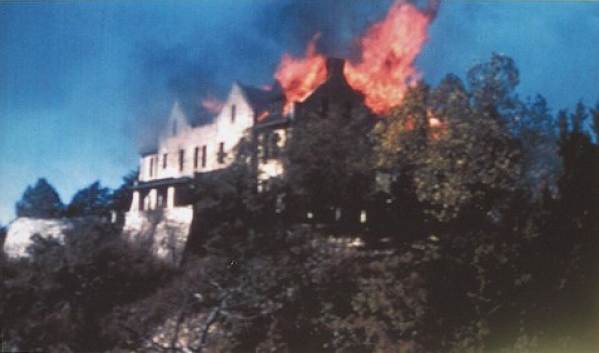
02 Ha Ha Tonka on Fire I had not seen a photo before of the old castle when it was burning. My aunt, Lois Pryor Cunningham (my father’s sister), was present the day it burned. She lived in Camdenton with her husband Lieutellus Cunningham Jr. and daughter, Carol. Occasionally she and Lou, as we called him, attended parties and other gatherings at the castle. At the time, Lou was prosecuting attorney of Camden County (photos 03 and 04).
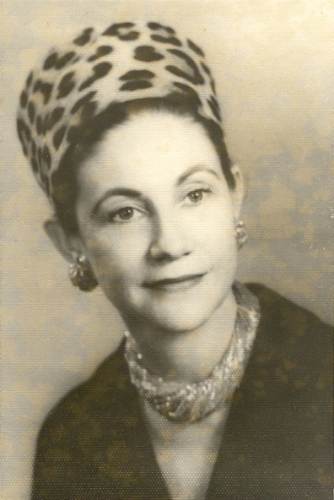
03 Lois Pryor Cunningham

04 Lieutellus Cunningham, Jr. In addition to the photo of the fire Mike also sent me other photos of the old castle and of the Robert Snyder family which purchased the land and built the Ha Ha Tonka Castle (photo 05).
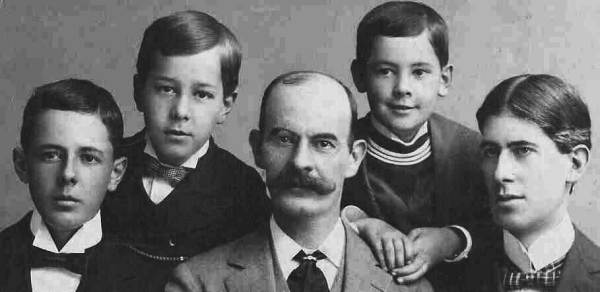
05 Robert McClure Snyder and Sons Here are three photos of the castle before the fire (photos 06, 07 and 08):
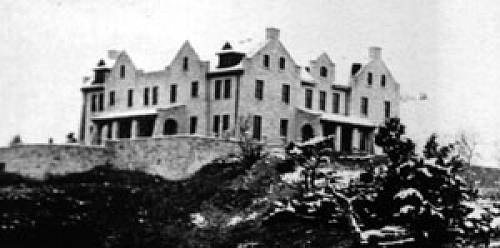
06 Ha Ha Tonka
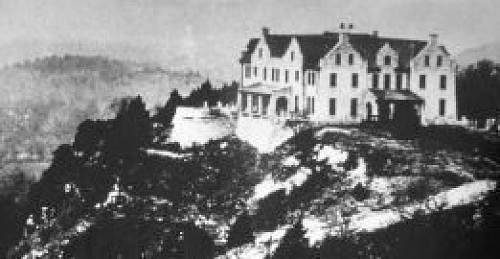
07 Ha Ha Tonka Castle
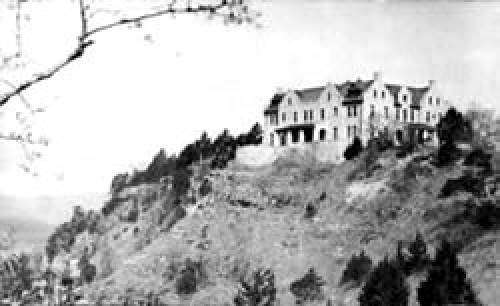
08 Ha Ha Tonka Castle Next are four photos of some of the rooms inside (photos 09 - 12):
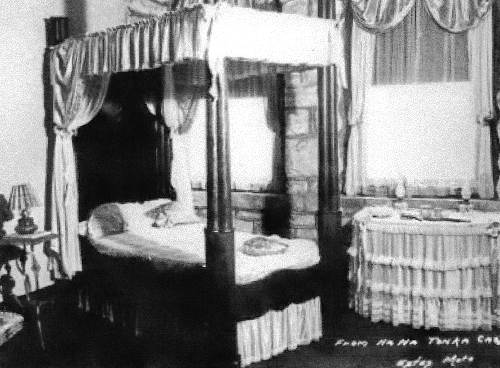
09 Castle Bedroom
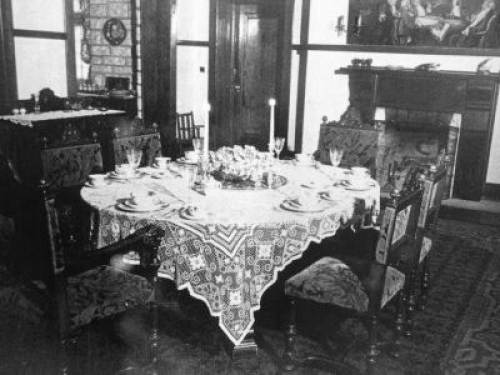
10 Breakfast Room
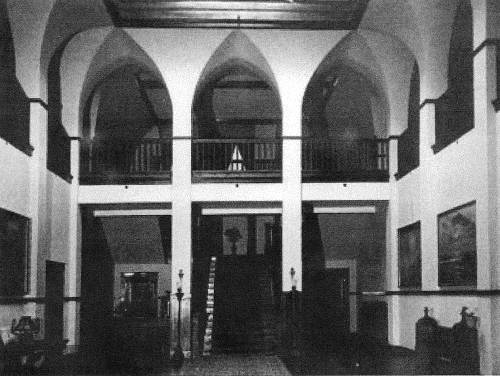
11 Entry Hall
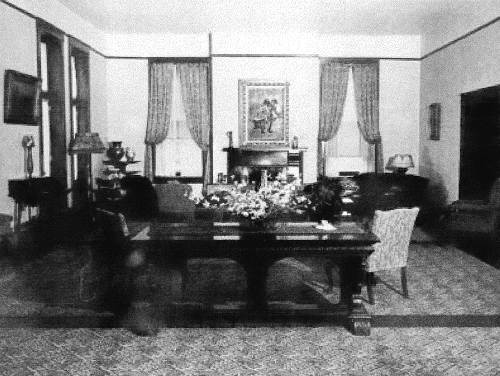
12 Dining Room Finally, here is a collage of the ruins after the fire (photos 13 - 39):
Just click on any of the photo thumbnails to view a larger image.
Note: Once you click on an image below, a new window will open. It would be best to maximize this new window by clicking on the middle box in the upper right-hand corner of the window. When you move your cursor over the image in this new window, it will change to a magnifying glass. Once this occurs, click on the image and it will show in a larger format for easier viewing.
Mike also sent me a history of the Snyder family:
Ha Ha Tonka
(An Osage Indian phrase meaning “Laughing Spirit”)
In 1903 Robert McClure Snyder who was a wealthy business man from Kansas City, Missouri first visited the area around Ha Ha Tonka. He worked in the wholesale grocery business in St. Louis and later in Kansas City. He began to speculate in real estate, banking and utilities, eventually amassing a fortune. He was so impressed with the area that he eventually purchased some 2,500 acres envisioning a private retreat for his family. This is what he said “Here I will spend my leisure, secure from the worries of business and the excitement of city life. I will fish and loaf and explore the caves of these hills, with no fear of intrusion.”
In 1904 Snyder purchased the property from Robert G. Scott. Mr. Scott had surveyed the property as a possible railroad route in the early 1890’s but then thought that this idea was not feasible. He was taken by the scenic beauty, high bluffs, caves and natural springs. He had changed the settlement from the name “Gunter Springs” to “Ha Ha Tonka” in 1895. Mr. Snyder immediately began to make extensive improvements. He envisioned a European style castle with a center atrium rising three and one half stories to a skylight, nine greenhouses, a carriage house, and an 89 foot private water tower.
In 1905 construction began on the mansion. He utilized stonemasons from Scotland and they quarried stone and timber from the immediate area as a European supervisor managed every step of the construction. The three and a half story masterpiece was designed by Kansas City architect, Adrian Van Brunt, and included a central hallway that rose the entire height of the building, as well as a stone carriage house.
In 1906 Robert M. Snyder was killed in an automobile accident on Independence Boulevard in Kansas City. It was one of the states first automobile accidents. The building of his mansion came to a halt at Ha Ha Tonka. The castle remained unfinished for sixteen years.
In 1922 Snyder’s sons Robert, Jr., Leroy, and Kenneth continued the work. The interior and upper floors were finally completed. The pace was slow and not nearly as elaborate as the original plans. The son Robert, Jr. lived in the castle (photo 40).
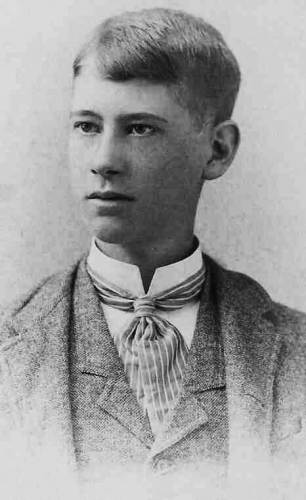
40 Robert McClure Snyder, Jr. In 1937 Robert Snyder, Jr. died. By this time the castle was finally complete. While he lived in the castle he was plagued by health problems. He cultivated an interest in local and regional history. He collected every book on the subject that he could get his hands on. He had a collection of over a thousand volumes. The family businesses began to decline and the depression and the court litigations (fighting the construction of Bagnell Dam) had depleted the family fortune and the surviving brothers were forced to take other financial steps with the mansion. They leased the building to a woman who operated the building as a hotel for the next several years.
In 1942 tragedy struck the castle when sparks from one of its many fireplaces ignited the roof. Within hours the mansion was gutted as well as the nearby carriage house. All that was left were the devastated outside walls of the mansion and the nearby water tower. Again the mansion was abandoned for the next 36 years.
In 1976 vandals torched the water tower and only the ruins of the castle remained. The water tower has since been restored to its original state.
In 1978 the State of Missouri purchased the estate and opened it to the public as a State Park.
Thanks Mike for all the photos and the narrative about Ha Ha Tonka!
Lieutellus Cunningham Jr. whom I mentioned above comes from an interesting family. His father, Lieutellus Cunningham Sr., was born at Bolivar, Missouri as was his son, Lietellus Cunnngham Jr. Lieutellus Sr. had a very distinguished career as an attorney and Missouri State Assistant Attorney General. He also was involved with much of the legal work associated with constructing Bagnell Dam in Miller County. The Cunningham family history has been researched; the following is taken from the Cole County Historical Society website:
Lieutellus Cunningham
The Cunningham family came to Virginia from Scotland before the Revolutionary War and several members served with the Colonial troops. James Cunningham, the great-grandfather of Lieutellus Cunningham, was born in 1765. He married Margaret Winning and located at Martinsburg now in West Virginia. She died February 20, 1810, nine days after their twin sons, Samuel and William were born. Their other children were Hugh, Josiah, Jane and James. He moved to Bellaire, Ohio in 1824 where William and Samuel helped to clear the farm and build a house of hewed poplar logs. He then married Nancy McGrew and their children were Edward, John, Wilson and Margaret. Samuel married Marinda Shahan and their children were Winfield Scott and Lieutellus James. William married Jemima Nesbit and their children were John James, Margaret, Sophia and Elizqabeth. John answered President Lincoln’s first call for troops and died in the service at Baltimore.
James Cunningham was born August 12, 1835, at Woodfield, Ohio, served throughout the Civil War in the 50th Ohio Volunteer Infantry, died December 24, 1915 and is buried at Bolivar, Missouri. He married Elizabeth Bickel who was born February 17, 1848 and died September 5, 1904 and is buried by his side. They came to Bolivar in 1873 and their children were Gertrude, Dorah, Harlan, Jessie and Lieutellus. Lieutellus Cunningham was born at Bolivar, Missouri, October 4, 1877. He was reared on farms in Polk and Cedar counties, educated in the public schools, Ash Grove Academy and the Missouri University. He was elected prosecuting attorney of Polk County in 1902 and again in 1906. When World War I came on, he volunteered for the first training camp and passed the examination at Springfield, Missouri May 2, 1917, but was not called for military service. He then turned his attention to civilian war activities and as chairman of the Polk County Chapter of the American Red Cross was instrumental in raising over forty thousand dollars for its work. He also served on the Legal Advisory Board and took part in the Y.M.C.A. and Liberty Loan campaigns.
He was a member of the 1922 Constitutional Convention and the author of the judicial plan adopted by that body, except the judicial council provision which he opposed until through his efforts it was amended to make the action of the council subject to the legislative branch of the government. Although opposed to inserting the anti-nepotism amendment in the Constitution, he was the first officer to give it life to support it in the Supreme Court. This was in keeping with his belief that when the people adopt a constitution, or an amendment, it becomes the supreme law of the land to be obeyed and enforced and not be disregarded or nullified. He was also the author of the provision giving soldiers and sailors the right to vote in all elections, and of amendments to the initiative and referendum.
He served as Assistant Attorney General of Missouri from January 1, 1927, to September 1930 when he resigned and became one of the attorneys in connection with the building of Bagnell Dam. He returned to Jefferson City and opened an office for the general practice of law in September 1931.
He married Maud Metier May 27, 1908, and the couple had two sons, Lieutellus, Jr., who practiced law in Camdenton, Missouri, and William James. Mrs. Cunningham was elected chairman of the Polk County Republican Committee in 1923, a member of the State Committee in 1924 and 1926, and Vice-chairman of the Republican State Committee in 1926. She was a delegate at large from Missouri to the 1928 Republican National Convention, and was in charge of the Missouri women’s organization in the 1928 campaign.
Mr. and Mrs. Cunningham were members of the Christian Church of Jefferson City, Missouri, and of the Ann Adams Hays Circle of the Ladies of the G.A.R. to which he was elected an honorary member. She was also a member of the P.E.O. and he was a life member of the American Red Cross, a member of the Cole county and Missouri Bar Associations, the Jefferson City Town Hall, the Cole County Conservation League, and of the I.O.O.F. and K. of P. Lodges.
A couple of weeks ago we were visited by Gloria Colvin Lenox and her son Chris at the museum (photo 41).
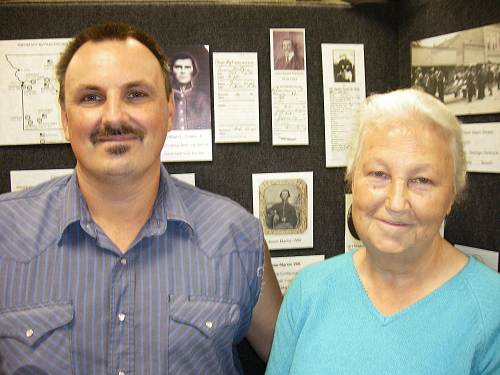
41 Chris Lenox and Gloria Colvin Lenox Although now living in the Eldon area Gloria was born and raised south of the river in Glaze Township on the original Colvin farm which was homesteaded by Sarah Cochran Colvin in 1897. The photo of Gloria and Chris was taken in front of our Civil War display; the soldier pictured between them on the display board is Jesse Marion Witt. He is the great great grandfather of Gloria. Jesse has quite an interesting history so I asked Gloria to tell me more about him. She told me quite a lot by memory and also informed me that her sister, Joyce Colvin Rodden, had kept family records and that she had photos of the Witt family going back to Jesse. Joyce and her husband Franklin (Bud) live on Bentown Ridge Road so I went over to their house the other day to see them (photo 42).

42 Joyce Colvin and Franklin Bud Rodden Indeed, Joyce has researched extensively both her Witt and Colvin family history. The descendency from Jesse Marion Witt to Joyce and Gloria's mother, Glee Witt Colvin, wife of Sterling Colvin is as follows:
Jesse Marion Witt (photos 43 and 44)
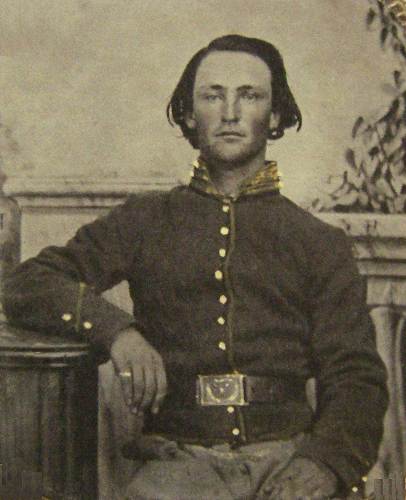
43 Jesse Marion Witt
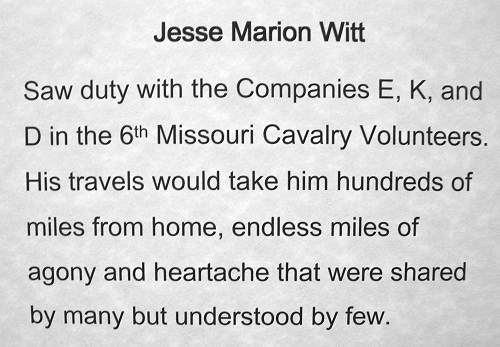
44 Jesse Marion Witt Caption John Witt (photo 45)
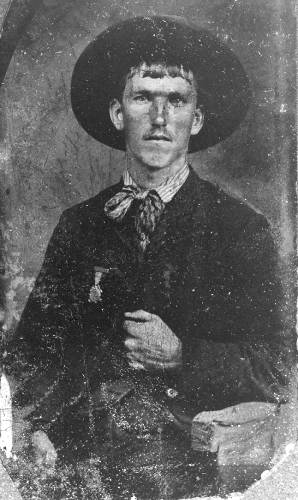
45 John Witt Clate Witt (photo 46)
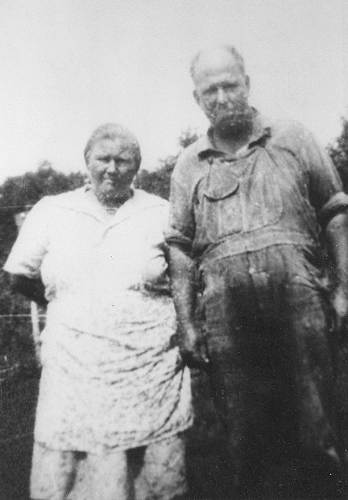
46 Clate and Ollie Shelton Witt Glee Witt Colvin (married to Sterling Colvin, son of James Carlee Colvin) (photo 47)
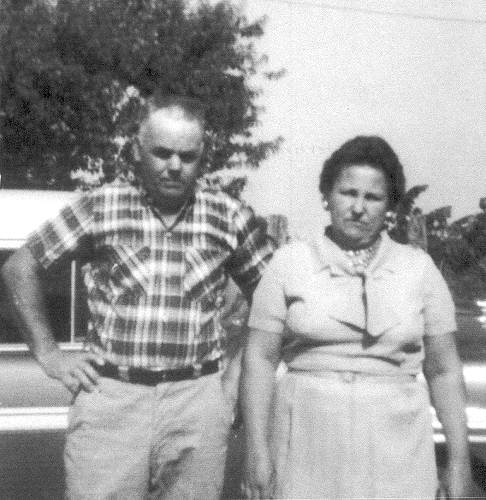
47 Sterling and wife Glee Witt Colvin Greg Huddleston of Brumley has written for our website a very interesting and poignant narrative about Jesse Marion Witt which I will copy here:
Patch-quilt Soldier
By Greg Huddleston, Brumley, MO
Jesse Marion Witt was a Miller County Civil War veteran, serving in the Union army as private of the 6th Regiment Missouri Cavalier Volunteers. Captured by the enemy, arrested for desertion, his is an extraordinary story of a Brumley, Missouri farm boy who went to war barely beyond his teenage years. He left as a youngster but returned aged and worn, robbed of innocence. Like so many veterans of so many wars, it was to remain with him for the rest of his life.
Jesse was born near Ulmon's Ridge (now Ulman) on 22 Aug 1841, a simple farm life was his lot and he quickly became accustomed to the rigors and discipline of this existence.
Missouri was on the cutting edge, supplying sons to both causes. Some fought for the North, others for the South, and some only fought for their own interests, using the war to satisfy personal greed, lust, or vengeance. It was indeed an age of lost innocence... especially to Missouri and to her people.
It was amidst this fury that Jesse Witt reached adulthood. He observed his 20th birthday while in the service of the Missouri Home Guards, Osage Valley Regiment, Company D., Joseph W. McClurg commanding. The Home Guards were the Union's answer to the Confederate State Guards which had organized first and were using this advantage in attempts to threaten the local population into supporting the southern push for secession.
Near Brumley, at Camp Union, in May 1861, the formation of these Union Home Guard companies was the first sign of Federal military strength in Miller County. They were not organizing to merely fight FOR the Union, but AGAINST the Confederacy which seemed to symbolize nothing short of terrorism and murder.
Young Jesse joined the Home Guards at Brumley on 22 June 1861 and was assigned to Company D. By fall, the ranks became decimated as the patch-quilt soldiers became bored with military life. They soon began to drift away to their homes and families. Crops needed to be harvested, preparation made for the coming winter, home and hearth had to be protected from the marauding bands of guerillas still active in the area.
After Jesse had served his 6 months of duty with Company D he prepared to leave his native soil and quiet farm life again when he stated he wanted to join up and fight for the side that was going to win. He made his way south to Rolla and on 10 Feb 1862, enlisted for 3 years as a private in Company E Wood's Battalion, Union Rangers, Missouri Volunteers. The company mustered on 15 February 1862 and was sent south to Lebanon where the Union forces were gathering to move against General Sterling Price's rebels in Springfield. Within 30 days, Jesse Witt and the 6th Missouri Cavalry would be at the Battle of Pea Ridge in Arkansas.
After Pea Ridge, the Confederates faded away to the east across the Mississippi River into Tennessee and Mississippi to join forces with Lee's main armies. Missouri and Arkansas Federals began to strengthen their hold on the Ozarks in the absence of the rebels. On 14 Dec 1862, 24 men of the 6th Missouri Cavalry were captured near Helena, Arkansas and Jesse Witt was among those taken. Fortunately for Jesse his capture did not last too long... on 21 December 1862, he was in a prisoner of war exchange and was back with his troops by the 27th. In February 1863, Jesse was listed as absent without leave and in March was listed as a deserter. On 25 Sep 1863, he was arrested for desertion and on the 29th was delivered to the military prison at Jefferson City. It is unclear where Jesse spent the next year of his life. It is possible he languished in a military prison. However his name appears as being present on all company rolls after October 1863.
In 1865, Jesse was part of a brigade of 7 companies attached to the District of Baton Rouge, Louisiana. There is no further explanation why they were on a detached service in July 1865, because the war had officially ended in April when Lee surrendered at Appomattox.
Jesse returned to Miller County in September 1865. By spring he began to pursue the dreams he had left behind that cold February day in 1862. On April 1, 1866, he married Martha Ann Luttrell. That winter their first child arrived. Little Hamen Witt was the first of six children to bless the marriage as the years went by.
His inability to perform prolonged manual labor worsened with age and prompted him to seek medical aid early in 1879. In 1890, Jesse filed for a disability pension. He was granted $2 per month. From stories told by his granddaughter, Verdie Witt Shelton, I believe he spent most of his final years with her family.
Jesse Marion Witt now rests in the Mount Union Cemetery southeast of Brumley. One can stand at his gravestone and survey the land he knew so well and travelled so often, now owned by his great-grandchildren and great-great-grandchildren. The battles of the Civil War ended in 1865, but the war was never over for Jesse. Perhaps he has finally found the peace denied him in life... one can only hope.
Thanks Greg.
The following obituary of Jesse Marion Witt from the Autogram offers more information about his family:
Jesse Marion Witt Obituary
The Miller County Autogram Newspaper, Tuscumbia, Mo, Thursday June 23,
1932, Page 3, Column 6
The Death Angel has visited our home again and taken from our midst another loved one. Jesse M. Witt was born August 22, 1841; departed this life May 31, 1932. He was united in marriage to Martha A. Luttrell April 23, 1866; to this union was born seven children, namely: George Witt of Marionville, Mrs Ruthie Drouillard of Terminal Island, Cal. Mrs W.T. Luttrell of Montreal, Mrs Frances Drouillard ( deceased ) Haman Witt, Tom and John of Brumley. Two have preceded him to the great beyond. He was a soldier of the Civil War. He enlisted in Co D 6th Mo cavalry in 1861 and served till 1865, but the greatest of all, he was a true devoted and faithful soldier of the Cross till death. He was set for the defense of the gospel, ready and eager to give a reason for the hope within him; his utmost desire and ambition in life was to be a Christian. He obeyed the gospel early in life. He was 99 years, 9 months and 9 days of age when the loving father saw fit to remove him from earth and earthly cares and from the evil which so often vexed his righteous soul.
Our lives cannot tell we miss him; our hearts cannot tell what to say; God alone knows how we miss him, in a home that is lonesome today. He will sadly be missed by us all.
Funeral services were conducted at the Mt. Union Cemetery by Rev. V.M. Smith where the remains were laid to rest to await the resurrection.
Written by a loving granddaughter.
Malinda Jane
Peggy Hake has written a short summary of the family history of the Witt family in Miller County:
There were several Witt families enumerated in Amherst County, Virginia during tax lists taken in 1783 and 1785. The heads of households included Abner, David, Elijah, George, Lewis, Littleberry, John, and William. Some familiar family names found in Amherst County records were Luttrell, Whittle, Shelton, Patterson, Phillips, and Gilliam.
By 1830, some of the Witt families had moved into East Tennessee and located in the counties of Rhea, Hamilton, Monroe, McMinn and Jefferson. Moving with them into East Tennessee were the Luttrells, Sheltons, Pattersons, and Gilliams. The Whittles went to central Kentucky.
John and Arthur Witt, probably brothers, were born in East Tennessee. They were sons of Jesse and Ruth Witt. John was born c/1804 and Arthur about 1808. Both men came to Miller County in the early 1840s after a short stay in Sangamon County, Illinois. This was the typical migration pattern of early pioneers.....the wanderlust drove these families from the Blue Ridge mountains of western Virginia, into the Cumberland region of East Tennessee, then on north and west into Indiana and Illinois, and finally to Missouri.
In Miller County's 1850 census, the two Witt families were living in the same area of Glaize Township. Back in Tennessee, Arthur Witt had married Mary Bilyeu and John Witt married Frances Coker. Both couples had large families. Some of the children were born in Illinois and some in Miller County.
The children of John Witt and Frances Coker (daughter of George Coker) were:
- NANCY WITT m. _____Gum
- RUTH WITT m. Gilbert Topping
- SALENA WITT m. Benjamin Workman
- ALTHA WITT m. Gainum Wyrick
- JESSE MARION WITT m. Martha Ann Luttrell
- CELIA FRANCES WITT m. Henry J. Luttrell
- WILLIAM J. WITT m. (1) Ferby Nicholds (2) Sarah Jane Thornton
- GEORGE WITT m. _____.
The children of Arthur Witt and Mary Bilyeu were:
- JOSEPH WITT m._____
- MALINDA WITT m. Carroll Dobson
- ELIZABETH WITT m. James A. Wyrick
- WILLIAM WITT m. Frances Luttrell
- ROSEANAH WITT m. John Kelly
- ISAAC WITT m._____
- REBECCA WITT m. Marcus Wyrick
- JOHN WITT m. Matilda______.
Among their neighbors in Glaize Township in 1850 were the families of Bilyeu, Golden, Wyrick, Russell, Gum, Long, Dobson, Beard, Nicholds, Williams, and Scott.
In Jenkins' History of Miller County is a paragraph, which states that near the close of the Civil War several families (mainly women and children) in the county were found destitute and near starvation due their husbands being away at war or else casualties of that war. Among them was Mary A. Witt, a widow of a Civil War soldier. I do not know who she was.....the only record I have of a Civil War soldier named Witt was Jesse Marion Witt, son of John and Frances. He survived the war and lived until 1932.
Most of the Witt families, who live in Miller County today, are descendants of Jesse Marion Witt (son of John Witt Sr.) and John Witt (son of Arthur Witt). The many daughters of these two families married into the families of Gum, Topping, Wyrick, Luttrell, Workman and Dobson. Their descendants are numerous and have scattered all over America. Over the years I have corresponded with Witt descendants who live in California, Utah, Oregon, Texas, and Colorado.
Peggy also wrote a short narrative detailing the tragic death of William Jasper Witt, brother to Jesse:
WILLIAM JASPER WITT (photo 47a)
From: The Miller County Autogram, 26 Feb 1891
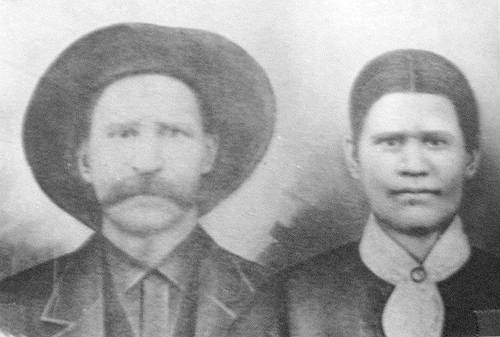
47a William Jasper Witt and Sarah Jane Thornton Witt "William Jasper Witt, one of Ira T. Johnson's assistants on the ferry boat, met with an accident about 3:30 Monday afternoon from which he died about 11 o'clock that night. The ferry boat is rigged with a windlass at either end of the boat for the purpose of heading the boat upstream. When the river is high, as at present (1891) these windlasses are very hard to work, requiring a strong man to handle them....The accident happened on the south bank of the river during preparations to return to this side. In turning the windlass, the iron handle slipped out of his hand and coming over, struck Mr. Witt almost on the top of the head, crushing his skull fearfully.....He was taken into Johnson's drug store where Dr. James B. McGee dressed the terrible wound. Before this was completed, the injured man became unconscious and remained in that condition until death.....The remains were buried at the Scott Graveyard (upriver from Tuscumbia) on Wednesday. Witt leaves a wife and a large family of children."
Note: The only Scott Cemetery that I know about is upriver from Tuscumbia but there is no record of Wm. Jasper Witt being buried there. He may be in an unmarked grave with no tombstone.
William Jasper Witt was born in Missouri about 1846. He first married Forbia N. Nicholas on 13 May 1866 by Andrew Brockman, a justice of the peace. In 1870 he and his family lived in Glaize Township near the families of Wyrick, Wickham, Witt, Renfrow, Myers, Casey, and Winfrey.
Sometime prior to 1877, his wife, Forbia/Ferby, died and on February 22, 1877 he married Sarah J. Thornton. Their marriage was performed by Hezekiah Robinett, a justice of the peace in Glaize Township. In 1880, they were living in Osage township near the families of Wyrick, Patterson, Hill, Lupardus, McCummins, and Topping.
William Jasper was the father of at least 6 children (some by his first wife and some by his second wife). They included:
1. Francis P. Witt b. c/1868 m. _____
2. John C. Witt b. c/1871 m. Addie Sanders 1890
3. William S. Witt b. c/1873 m. Emma Wright 1902
4. Allery A. Witt b. c/1878 m._______
5. Joel L. Witt b. c/1880 m. Lucy Stark 1905
6. Livonia Witt b. c/1885 m. George W. Wilson 1906
During the 1880 census of Miller County the following people were residents and business persons in the town of Tuscumbia:
Hauensteins - storekeepers
Elias Swalem - attorney
James B. McGee - medical doctor
Abe Fulkerson – newspaper owner/publisher
Daniel Cummings - storekeeper
Ira T. Johnson – owned a ferry boat & a drug store
Jacob Gantt - attorney
David Marshall - riverboat captain
Samuel Sone - teacher & educator
Page Thompson - shoe maker
Joel B. Clark - County Courthouse employee
Theodore Robinson - attorney
James Todd - Judge of the Probate Court
Pinkney Miller - (rumored to be the first white child born in Miller Co.)
Lewis Lesem - attorney
Henry Bradleyford - physician
(Note: It was interesting to see that the small village of Tuscumbia had 4 attorneys in 1880!)
Ira T. Johnson, who employed William Jasper Witt on his ferry boat, was also the owner/operator of a drug store in the small town. Ira was born and reared in Ohio. His wife, Elizabeth (Weitz), a native of Germany, helped him in the drug business.
After the death of William Jasper, his wife Sarah Thornton Witt, married Edington Williams on 23 Sept 1893 and she had 2 more children by Mr. Williams.
Here are a number of photos of the Jesse Witt family taken many years ago which I copied from Joyce’s collection. The first is a family photo taken in 1903 near the Mt. Union Cemetery. In the back line of Witt family members Jesse Witt’s sons John and Tom Witt (number 5 and 6 on right) are not named in the caption (photos 48 and 49).
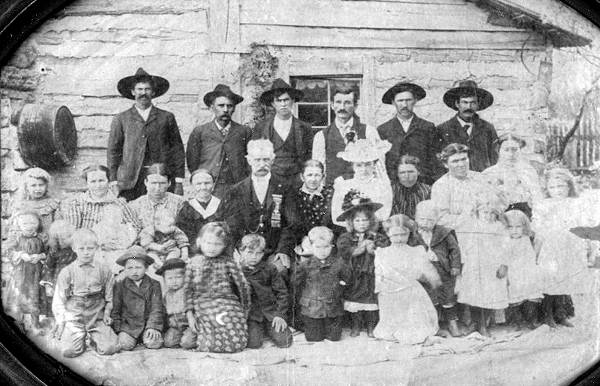
48 Jesse Marion Witt Family
Click image for larger view

49 Caption for Jesse Witt Family Picture
Click image for larger viewNext is a photo of Jesse and Martha Luttrell Witt (photo 50).
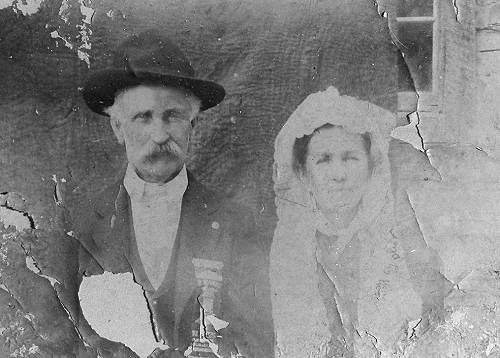
50 Jesse Marion and Martha Luttrell Witt Here is a photo of the Witt family (photo 51):
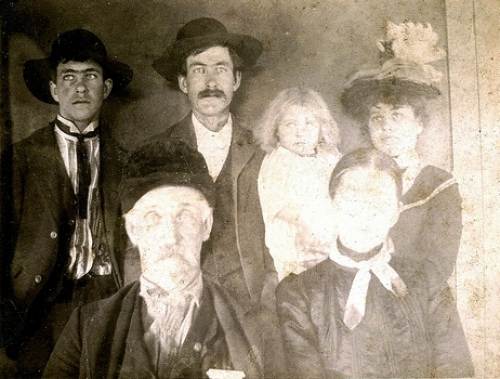
51 Witt Family - 1901 - Jesse, Martha, George, Tom, Ruth and Verdie In 1901 a birthday celebration for Jesse was photographed (photo 52).
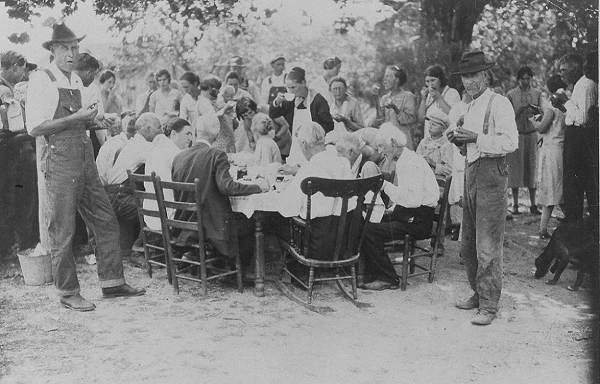
52 Jesse Witt Birthday Party
Click image for larger viewJesse is the white haired gentleman seated at the right side of the table. Here is the caption for that photo (photo 53):
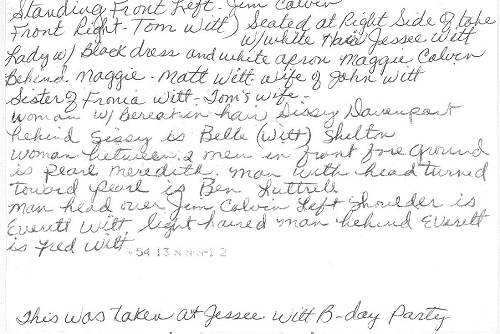
53 Jesse Witt Birthday Party Caption
Click image for larger viewGreg Huddleston has written a detailed biography of Jesse Marion Witt which you can read at our website.
Once you go to this website scroll down the page until you reach the article about Jesse. It is a long article so I am referring you to Greg’s original site for those who want to read more about Jesse Marion Witt. Here is a photo of young Jesse in military uniform with a pistol that Greg found for his story (photo 54).
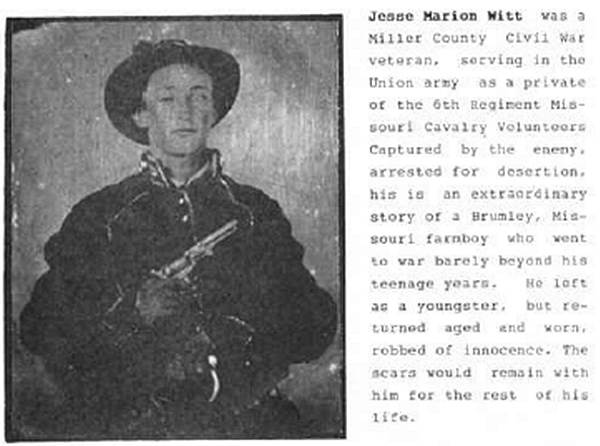
54 Jesse Marion Witt
The interesting thing about Joyce Colvin Rodden and her sister Gloria Colvin Lenox is that their Colvin heritage is as interesting as their Witt heritage. Their mother, Glee Witt Colvin, was the great granddaughter of Jesse Marion Witt (photo 55).
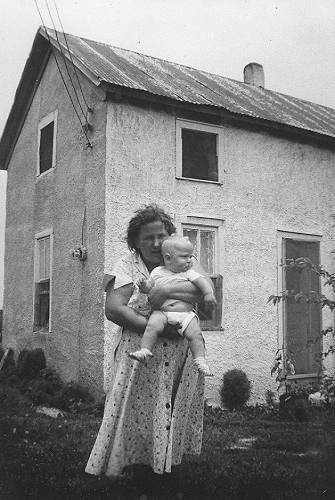
55 Glee Witt Colvin wife of Sterling with son Tim Glee married Sterling Colvin (photo 56), who was the son of James Carlee Colvin (photo 57), who was an important Miller County officer on the county court in Tuscumbia in the 1930’s.
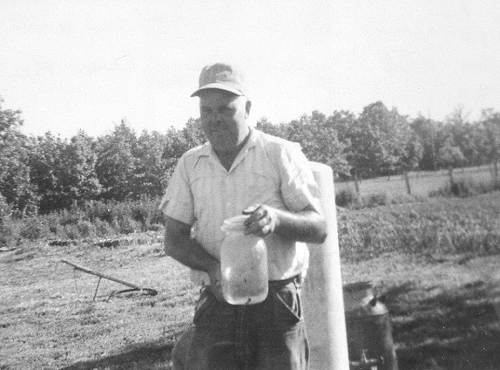
56 Sterling Colvin
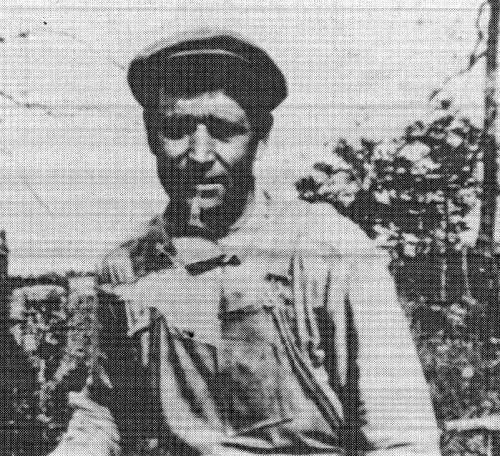
57 Judge James C. Colvin James Carlee was murdered in a sensational criminal act in 1934. The story was summarized in an article in the Autogram:
Tuscumbia Autogram
05 October 1937
Must Serve Life Term For Murder of Judge Colvin
“Supreme Court Affirms Sentenced Imposed on Sam McCracken By Lower Court”
A life sentence given Sam McCracken, Camden County farmer, for killing his neighbor and tenant, Judge J.C. Colvin, on October 6, 1934, was affirmed Friday by the State Supreme Court at Jefferson City.
Judge Colvin, who served in Miller County two terms, 1923 to 1927, inclusive, as Judge of the County Court from the Second District, was shot to death following a quarrel of six months duration.
The trouble came up over the rental of the McCracken farm, which Judge Colvin was cropping. McCracken, who had paid a big price for the farm, had lost the farm by foreclosure, and the place had been rented from the new owner, but McCracken refused to give Colvin possession of the house.
Judge Colvin, being unable to get peaceable possession of the residence, had moved into a small building on the farm.
He was gathering corn and had gone to the field early in the morning to shuck some corn. His attention was attracted by a sack of corn beside a shock, which he had not placed there. He was investigating the sack, when McCracken shot from ambush. Apparently, he had crawled about 10 feet after being shot. Portions of his face and arm had been shot away. He had expired by the time neighbors, who heard the shot, had reached the scene.
McCracken, when accused of the crime following his arrest by Sheriff Eidson, declared he “had to kill Colvin.” McCracken was reputed to have an ill temper and possessed of a quarrelsome and contentious nature.
The higher court now says that McCracken must serve the lifetime sentence.
(Note: Sam McCracken was confined to the Missouri State Penitentiary at Jefferson City, Cole County Missouri, where he spent eighteen years and six months and died on 11 March 1954, of cardiac vascular disease. He was embalmed and buried in the Rolla Cemetery, Rolla, Phelps County Missouri burial plot.)
You can read more about the James Colvin murder at this previous Progress Notes.
A book written by some of James Colvin’s descendents gives the complete story of his murder and the trial of Sam McCracken (photo 58):

58 Wet Glaize Ambush Book Information Joyce told me that her grandfather, James Carlee Colvin, had gone to the farm in Camden County because the cropland was better there. Here is a photo of the house in which he and the family lived the short time he was farming as a tenant farmer (photo 59):
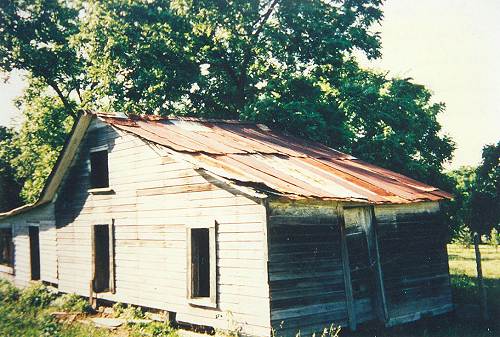
59 Colvin home on Auglaize where James was killed He, however, maintained ownership of the original Colvin farm in southern Glaze Township which is still in the Colvin family presently.
Here is an early photo of the James Carlee family (photos 60 and 61):
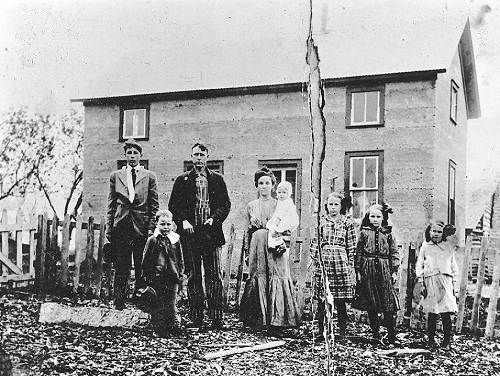
60 James Carlee Colvin Family
Click image for larger view
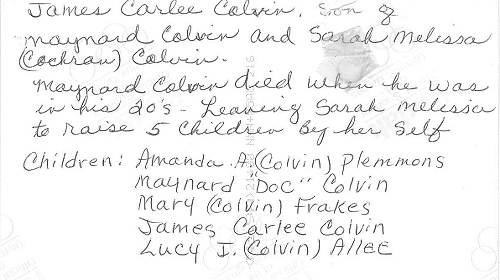
61 James Carlee Colvin Caption
Click image for larger viewJames’ father, Sterling Maynard Colvin, had died early in life and his mother, Sarah Melissa Cochran Colvin, had to take over the management of the original Colvin farm in Miller County. She was the one who completed the paperwork for homesteading the farm in 1897. Here is a portion of the official declaration of the homesteading of the property (photo 62).
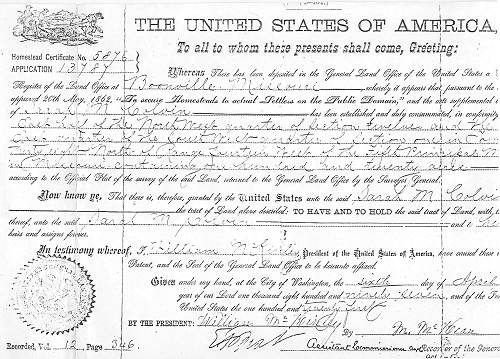
62 Homestead Information
Click image for larger viewLater, she deeded the property to James Carlee Colvin (photo 63).
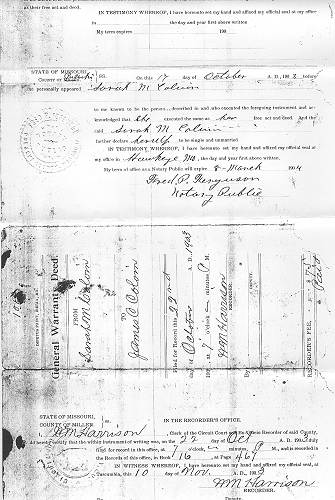
63 Abstract property turned over to James
Click image for larger viewJames Carlee was a hard worker. Before moving to take the tenant farming opportunity in Camden County he built a large concrete home which was very popular in those days (photo 64).
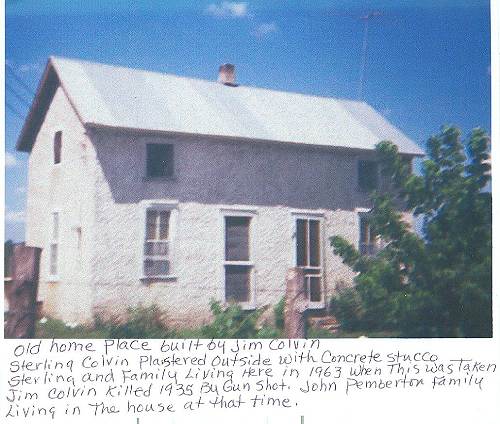
64 Old Colvin Home
Click image for larger viewYou can read about the history of concrete homes in Miller County at this previous edition of Progress Notes.
James Carlee Colvin was married to Maggie Fendorf, a daughter of Henry Fendorf (photo 65).
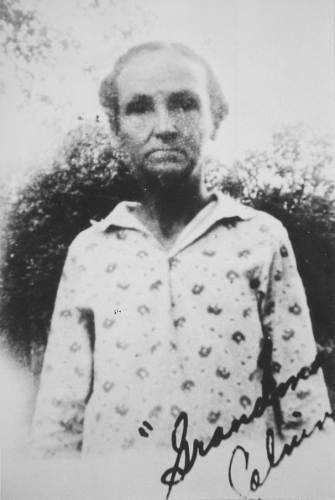
65 Maggie Fendorf She was a sister to Frank Fendorf who had a large general store in Tuscumbia in the first part of the last century. Frank Fendorf is the grandfather of Helen Fendorf Phillips of Eldon.
It was the concrete home pictured above where Joyce and Gloria's father, Sterling, was raised (photo 66).
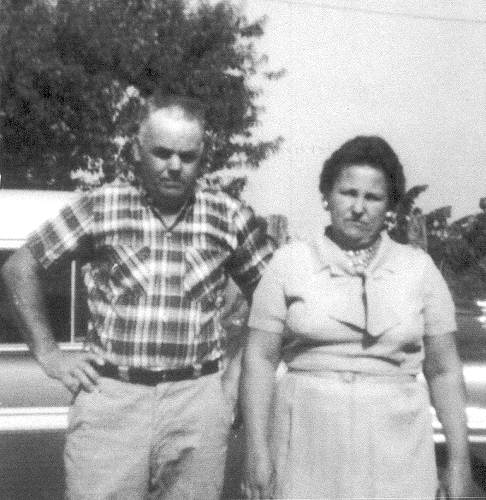
66 Sterling and wife Glee Witt Colvin As noted above, Sterling had married Glee Witt, great granddaughter of Jesse Marion Witt. Here is a copy of the plat map of Miller County demonstrating the location of the historic Colvin farm in Section 12 of Township 38N Range 14W (photo 67).
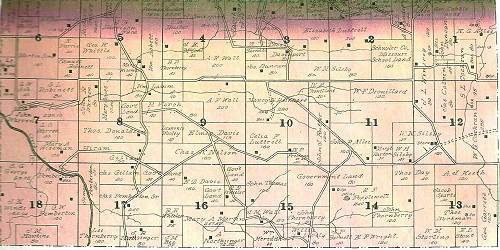
67 T38N - R14W - S12
Click image for larger viewThis location is at the southwest corner of Miller County.
Judge Colvin, as he was known around the Miller County area, was a brave and courageous man. He heroically saved the life of a woman on a runaway horse in 1925. Here is that story as taken from the Autogram:
Miller County Autogram May 7, 1925
Wild Horseback Ride A Very Near Tragedy
Judge J.C. Colvin Saves Life of Mrs. Mary Keeney Monday
Mrs. Mary Keeney of Hugo, Camden County owes her life today to the fact that Judge J.C. Colvin happened to be coming to Tuscumbia early Monday morning to attend court and also to the quick wit of the Judge and to his determination to stop a plunging, kicking horse at all costs.
As the Judge was driving along at a lively rate near the Charlie Jenkins place, this side of Ulman, he heard screaming ahead of him and just an instant later he saw coming toward him a dashing horse with a woman clinging desperately to the horse’s mane and one of her feet caught in the stirrup. He threw the emergency brake and even before the car stopped he was out of the car rushing toward the approaching horse. He saw it was going to take a desperate effort to catch the horse as it turned from the main road and started east, down the lane from the Jenkins’ house. But in a hair’s breadth he was able to grasp the bridle and after a struggle with the horse he was able to hold him.
The woman was speechless with fright and the horse was shaking with fright as well. After Mrs. Keeney regained her speech she told how the accident occurred. She said that she had stopped to tighten the girth of the saddle and when she attempted to mount again, her foot slipped through the stirrup. This frightened the animal, and while in this position the animal began to plunge and run. She maintained her position, holding to the horse’s mane until the animal was caught by the Judge. Her strength had almost failed her when she was rescued from her perilous position. Judge Colvin offered to take her to Ulman, but she said she was not injured, and after mounting the horse, she proceeded on her way, apparently no worse for the wild ride except for the nervous shock.
Mrs. Keeney resides near Hugo, Camden County. She was returning home from Tuscumbia after having visited her sister, Mrs. James Wright.
So that completes the story of two very interesting Miller County families, the Witts’ and the Colvins’ told by Gloria Colvin Lenox and Joyce Colvin Rodden. As it so often happens, I wouldn’t have had this story to tell if Gloria had not been visiting the museum at the same time I was present. Almost always, I learn something or another from our many visitors to the museum.
You can read more about the Colvin family of Miller County as written by Peggy Hake on our website.
You will need to scroll down the page to find the section about the Colvin family.
Once again this week I will present an installment from the book "Ozark Superstitions" by Vance Randolph the Ozark folklorist. You can read more about him from last week’s Progress Notes. This week, Vance discusses Ozark people’s traditions regarding weather signs and predictions pages (photo 68).
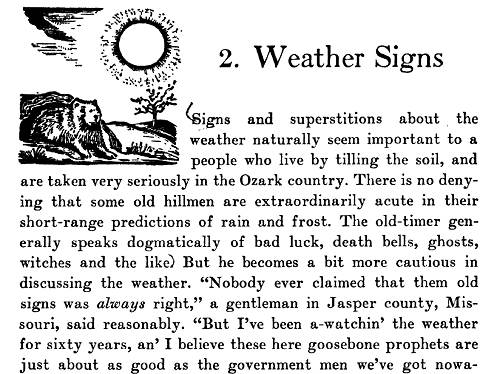
68 Ozark Superstitions - Weather Signs
Click image to read entire chapter in PDF format
For those of you who missed seeing photos and videos I downloaded on last week’s Progress Notes after the Tuscumbia Osage River bridge implosion on Tuesday, be sure and take another look for some exciting photos and videos.
I have some more photos this week which are circulating on email chains taken by Allen Bodkin (photos 69 - 80):
Just click on any of the photo thumbnails to view a larger image.
And here is a particularly good one by Ginnie Duffield (photo 81).

81 Gone Now
Just before 9 a.m. Tuesday, Aug. 31, the center of the old bridge at Tuscumbia was blown up and dropped into the Osage River. This photo was taken from a video of the demolition, which is available on the newspaper’s website. At right is the new bridge, which some area residents are now calling the “Bridge to Everywhere” after it got dubbed “the bridge in the middle of nowhere” or “the bridge to nowhere” by national media pundits shortly after construction started in Feburary 2009 as the first federal stimulus project.
(Photo by Ginny Duffield)
That’s all for this week.
 Joe Pryor
Previous article links are in a dropdown menu at the top of all of the pages.
|

